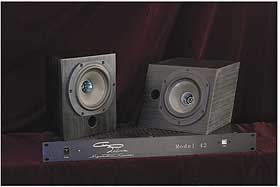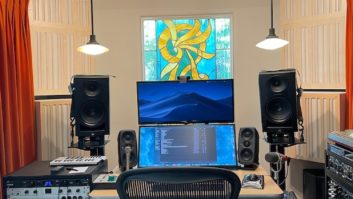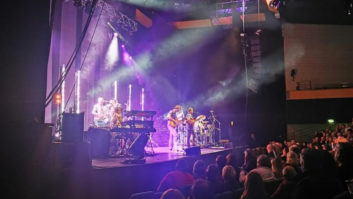
To maintain their small footprint, the Model 42 speakers come with external amplification and DSP.
It doesn’t happen often, but every once in a while I encounter a studio near-field reference monitor that really gets me jazzed about listening. A relative newcomer, the Pelonis Sound Model 42 is ready to make its mark in control rooms everywhere. Created by award-winning studio designer Chris Pelonis, the Model 42 is the newest release in the Pelonis Signature Series, which ranges from the two-way PSS110P to the four-way, 1,000-watt, dual-15 Model 215AW active reference system. All the Pelonis monitors are based on Tannoy’s Dual-Concentric coaxial drivers, with custom cabinets and electronics.
ENTER THE MODEL 42
The smallest in the line, the Model 42 puts 4-inch, two-way Dual-Concentric drivers into patent-pending, rhomboid-shaped enclosures that are fed from a single-rackspace DSP controller/crossover/amplifier unit. The Model 42s are barely larger than an Auratone cube, but don’t let their diminutive size fool you. Beyond those 6×8-inch front-ported baffles, there’s a lot going on. Rather than going the self-powered route, with electronics inside the speakers, Pelonis opted for an external system controller, which offers numerous design advantages. The speaker boxes can be kept as small as possible—there’s no need to supply AC power to each speaker—and the design/selection of the crossover and amplifiers is not compromised by the requirements of space and/or heat management, which are two major considerations in any self-powered speaker.
The controller’s custom, 4-channel Class-D amp delivers 100W to each of the 4-inch multi-fiber, paper-pulp cone woofers and coaxial neodymium magnet HF drivers with 0.75-inch titanium domes. The rack also contains the active crossovers and a DSP section for system tweaks, accessible via a front panel USB port for connection to a free Mac/PC control app. Inputs are Neutrik combo XLR/TRS jacks (with a -10/+4dB sensitivity switch) that accept balanced or unbalanced lines. Amplifier outputs are standard five-way binding posts.
Setup is easy—it’s mostly plug-and go. However, this is a bi-amplified system with external connections via (supplied) 3-meter speaker cables with tinned bare ends. You really need to double-check how you’ve attached those eight speaker terminals on the amplifier end and the four on each speaker to ensure proper polarity and that the HF and LF lines are not reversed. Some color-coding to prevent the (disastrous) latter condition would be a nice addition on future models. Another possible improvement would be a recessed sensitivity switch. I accidentally bumped it, changing the setting several times while connecting all those speaker lines during setup.
The software provides access to DSP parameters, although this is optional and not necessary to operate the monitors. The app is fairly basic—the GUI isn’t exactly slick, but it is easy to use and navigate. From a main page, you have remote access to controlling mute, L/R speaker solo, L/R level match, alignment delay (1 to 10 ms) on either side or both, and a versatile system equalizer. The EQ is a 5-band parametric, with the two outer bands switchable to provide LF or HF shelving control. Designed for system tweaks, the EQ has a +3/-18dB gain range and adjustable Q from an ultra-wide 0.5 to a narrow, surgical 20 ratio. The software can store an almost endless number of DSP presets, so you could create an entire library of tweaked settings to emulate other monitors, presets for different rooms they work in or “how I like it” preferences.
THE SOUND
The DSP access for tweaks is nice, but the Model 42s sound great right out of the box. The effect is listening to a much larger speaker. The LF response is down about 3 dB at 75 Hz, but there was no feeling of “where’s the bass,” and these are nearly ruler-flat out to 20 kHz, with HF extending beyond 35 kHz. Pelonis is currently working on an optional subwoofer; in the meantime, I also tried the 42s with a JBL LSR sub with great results. The key to the Model 42’s sound is its consistent response at nearly any volume, with the bass only becoming nonlinear at extreme (i.e., painful) levels. The system offers tons of headroom and incredible levels of low-level detail with no distortion or listening fatigue.
The use of the rhomboid shape is brilliant. Placed on the meter bridge in my main control room (almost exactly ear level), the slanted front baffle pointed the speakers slightly inward—right on-axis. For studios with a very high meter bridge, the 42s can be rotated on their side to point slightly downward. I later used them in my video post suite at desktop level; here, the 20-degree slant was just right to keep the monitors pointed slightly upward toward me. This proved to be a real revelation—near-field listening without console reflections! Anyone looking for a new slant in monitoring should check these out.

Click on the Product Summary box above to view the Model 42 product page.







